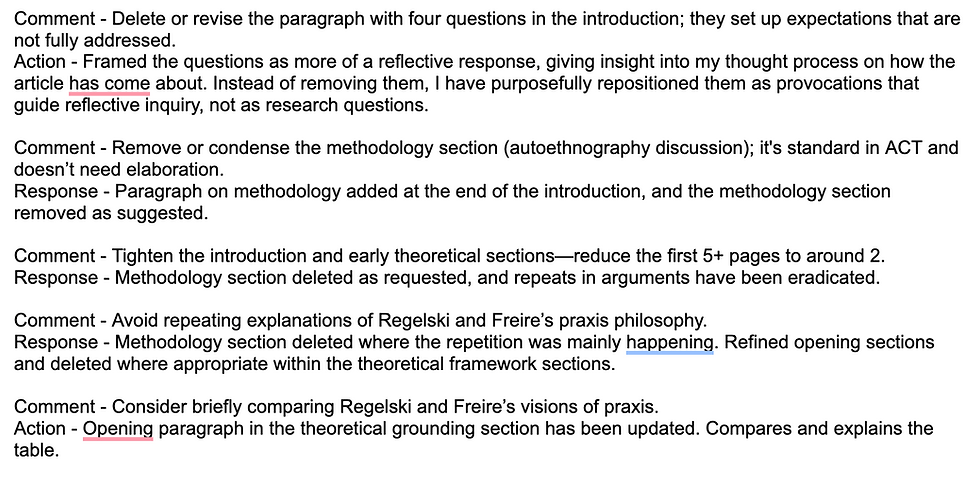Accepted with Revisions… But Not Revisions Like Before
- ricketts15
- Aug 31
- 2 min read
When I received the initial response from Action, Criticism, and Theory for Music Education (ACT), it read: “Accepted with revisions.” Relief, excitement — all the usual emotions you might expect when submitting to a journal I’ve admired for years.
But what followed was, without question, the most demanding revision process I’ve ever undertaken.
This was the first time I’d proposed a conceptual model — PRAAX: Participatory, Reflexive, Agentic, Authentic, Cross-cultural — a framework grounded in the tensions of classroom life and informed by the writings of Regelski and Freire. And although the article had been “accepted,” the revisions weren’t minor. They required a deep structural reworking and rethinking of how I framed my arguments and articulated theory.
Most of my previous publications have involved case studies, autoethnography, or critical reflections, all grounded in practice, without attempting to introduce new models or frameworks. With PRAAX, I was introducing something new and giving it a name. That came with a different kind of responsibility. The reviewers, to their credit, didn’t let me off lightly.
Their comments were generous but rigorous:
Clarify and justify your use of Freire (and Regelski) — don’t just cite them, dialogue with them.
Avoid overloading the model with values — five principles is a lot; make sure each one earns its place.
Reduce redundancy — several principles overlapped in content and tone.
Support your assertions with evidence, especially when describing tensions such as repertoire selection, group dynamics, or informal learning.
Restructure the article — the order of sections needs to reflect the logic of your argument better.

What initially felt like just another round of revisions soon became a complete reframing of how I thought about the article.
I restructured and justified the strands of the PRAAX model. I tightened every paragraph to cut repetition and clarify tone. I rewrote the metacognition section to explain better why scaffolding matters before voice. I brought theory and classroom insight into sharper conversation. And, critically, I let go of any temptation to defend what I had already written, and instead focused on what the article needed to become.
It was uncomfortable at times, but it motivated me to improve my scholarship.
And maybe that’s the point......
When the final acceptance came through, it meant more than just adding a publication to my CV. It meant that a model I’d developed through classroom experience, ethical questioning, and academic dialogue had been taken seriously, and not just by a practitioner-friendly outlet, but by ACT, a journal known for its theoretical depth and critical edge.
More than that, it was published as part of the Thomas Regelski Special Edition, a space dedicated to honouring a scholar whose praxial philosophy had shaped the entire article. That full-circle moment wasn’t lost on me.
Key takeaways from this process are:
“Accepted with revisions” can be far more intense than a first rejection.
Conceptual frameworks demand clarity, humility, and iterative thought. Alongside being grounded in theory!
A strong review process is a gift, even if it feels bruising at first.
Publishing doesn’t begin or end with a submission; it is part of praxis!





Comments